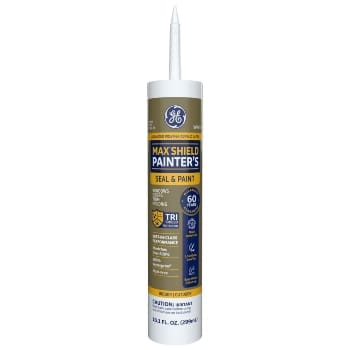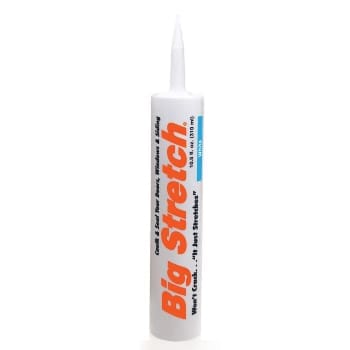
 By
Matt
January 3, 2022
By
Matt
January 3, 2022It's inevitable you'll need to fill a gap or seam in your house or while working on any project. There are many different products you can use for this type of job, but the difference between caulk and sealant is not always apparent. Caulk and sealant are two different substances and as a homeowner you need to know the difference so you won't make a costly mistake.
In addition to filling gaps, caulk and sealants improve the appearance of your home. Some of these products have been designed to keep water out, to keep insects out, and some even serve as firestops around chimneys and vents.
However, the way each product performs differs greatly depending on its purpose. Caulk is much more rigid than silicone and polyurethane sealants. If a large amount of movement takes place in a joint where you have used caulk, the joint will end up having to be repaired due to cracking or tearing. Using a sealant would be a better option in this situation.
In this article, we'll explain the main differences between these products so you can choose the right one for your next project.
Caulking is a type of sealant used to seal up gaps around openings in and around different substrates such as wood, brick, stone, and vinyl. It's also commonly used on pipes and in various industrial applications.
Caulk was invented in the nineteenth century by John Dicks, after improving upon the idea and products from his father who created a caulking putty. It was an invention that would change the construction industry forever. He had an idea that would allow his new product to be easily spread and molded. The material was also long-lasting, and the ability to be painted after drying gave it an advantage over similar materials. He mass-produced these products, and his company eventually grew to become the leading supplier of caulking to the home improvement market. The company began selling caulk in small packages, which are still widely available today, in the 1950s. Latex acrylic and silicone caulk were developed later, making the products easier to work with. They are all capable of drying slowly and without cracking.
As for sealants, they are a more recent invention and started with silicone-based adhesives which were developed in the 1980s. Silicone sealants are a rubbery material that are extremely flexible and durable, and they became popular among homeowners who wanted to protect their homes from their elements with something flexible and long-lasting. Even today, silicone sealants are one of the most popular sealants on the market.
Caulking products are now more popular than they've ever been. Today's caulk seals better, stretches further, and lasts longer. There are a variety of caulks on the market today, each with its own characteristics. Caulk comes in a variety of colors and textures, so familiarize yourself with them before you buy a caulk gun and start caulking your house.
As for sealants, they were first used when people built houses, whereas caulking dates back to the days of boat building. Rather than using the term caulk as a generic term, many companies now refer to their high-performance products as caulk or sealants. However, in the vast majority of cases, these products serve the same purpose. Sealants fill in gaps between different types of building materials, helping to keep water and air out of a structure.
Caulk and sealants can fail for a variety of reasons, but usually are a result of improper surface preparation or using an incorrect product for the job. So consider what you want a product to accomplish and buy the right type for the job.
Caulk is commonly used inside the home, around windows, doors, and trim. In general, most caulk is only recommended in areas with less than a half inch of gap between two surfaces. It's also worth noting that generic acrylic latex caulk doesn't offer a waterproof seal and therefore shouldn't be used outdoors when exposure to water is possible.
Sealants offer superior elasticity and better water-resistance than caulk. Caulks tend to shrink when cured, whereas sealants do not. Sealants are smart choices for areas that experience frequent temperature changes and high moisture levels.
Caulk and sealants are very useful for sealing cracks and holes around windows, doors, and other openings. There are many different types of caulk and sealants available depending on the project and the climate. Some are designed for use indoors while others are meant for outdoor applications.
The most common type of caulking used in homes is acrylic based. It comes in two forms: regular and waterproof. Regular caulk dries clear but does not hold up well against outdoors because it has a low resistance to moisture. A waterproof caulk, such as one that has an acrylic based with added silicone, holds up better against water and humidity and is perfect for use in and around bathrooms, tubs, and showers.
Outside a house, it's best to avoid the use of acrylic caulk and stick to pure silicone or a hybrid caulk designed for outdoor extreme weather. If you don't know what to pick and you're looking for something that will last under extreme weather outside, then stick to a silicone based sealant if the area you are sealing is non-porous.
Sealants, such as silicone or hybrid types, works well on a variety of surfaces, including the surfaces of most bathroom materials. Silicone sealants comes in two varieties: pure silicone and silicone-latex.
When applying a silicone sealant caulking compound to a rough surface, choose one that is designed for the substrate. Silicone does not expand or contract in response to temperature changes. Furthermore, silicone caulk is less expensive than rubber or acrylic caulk. A silicone caulking compound, on the other hand, does not readily accept paint so make sure to plan ahead if you want the caulk to match a surround color.
But what if you want a paintable caulk? In that case, assuming your caulking inside your home, then use an acrylic latex caulk with added silicone. It's easier to apply and manipulate than pure silicone caulk, it's paintable, and it helps create a watertight seal. The downsides to siliconized acrylic latex caulk are that it doesn't expand as well as silicone caulk (though it's a much more flexible material than acrylic latex caulk without added silicone). It also doesn't last as long as pure silicone caulk.
Acrylic latex caulk is a type of traditional caulk made up of latex polymer, acrylic, and a few other ingredients. As a result, a strong sealant with excellent physical and chemical properties is created.
It's a good caulk to use indoors because it's usually non-toxic and has little to no odor when dry. Another advantage that many people appreciate is the time it takes to set up this type of caulk. Some brands cure in about 30 minutes, while others can take up to 24 hours or even a week to fully cure.
What are some of the disadvantages of using acrylic latex caulk?
The most common issue when using this type of caulk is squeezing it out of the tube nozzle too quickly in order to complete the job faster. The problem with going too fast is that it can cause cracks and bubbles in the caulk bead.
As a result, take your time and slow down. Thicker coats tend to work better with this type of material, despite the fact that they take longer to dry, but be careful not to go beyond the recommended gap size.
Siliconized acrylic latex caulk is a moisture-resistant sealant used to fill gaps in the home where regular acrylic latex caulk would fail. It's a latex and silicone-based flexible caulk that adheres to most surfaces while also being tough enough to withstand moderate cracking, minimal expansion, and some moisture.
It's a popular bathroom caulk, especially for use around a tub, ceramic tile, and baseboards. However, because its waterproofing is inferior to that of 100% pure silicone or an advanced polymer hybrid caulk designed for outdoor use, it is not recommended for use outdoors.
Siliconized latex caulk is available in a variety of sizes and colors, including white, off-white, and clear. This caulk is resistant to mildew and mold. It can also withstand moderate changes in temperature without losing its shape or consistency.
Silicone caulk is the best choice when flexibility and water exposure are required. It has a much higher heat, cold, and humidity resistance than latex acrylic caulk. It sticks to a wider variety of surfaces (except porous surfaces such as brick, stone, and wood). It does not discolor or turn yellow over time. When exposed to sunlight for an extended period of time, it will not degrade.
As a result, silicone caulk is a better option for sealing windows, doors, and decks on the outside. Although acrylic caulk can be used for these purposes, it is less durable and reliable due to its lack of joint movement and water resistance.
When each of these characteristics is considered separately, silicone caulk is a better choice for interior applications than acrylic caulk. When it comes to sealing around tubs and showers in the bathroom, silicone caulk is more versatile than acrylic caulk. The same is true of window glazing and door weather stripping.
There are a few disadvantages to silicone caulk that you should consider before choosing it over acrylic caulk. Silicone caulk is more difficult to work with because it is stickier and more difficult to clean up when mistakes are made or excess product is left on the surface.
It also struggles to adhere to porous surfaces such as brickwork, masonry, and wood. A hybrid caulk is a better choice for outdoor projects in these cases. Finally, the surface moisture level should be completely dry during application in order to get a good grip with the silicone caulk.
A elastomeric sealant is a type of specialty caulk that's different from silicone, acrylic, or polyurethane. Among the products in this category (also known as hybrid caulks) are OSI Quad and Sasco Big Stretch.
Each of these products has its own advantages and disadvantages. Elastomeric sealants have the advantage of providing a strong seal on porous surfaces, as well as being paintable. This caulk is an excellent choice for sealing gaps around an aluminum water table, a brick-encased exterior window, and as a door caulk. Elastomeric sealant caulk can also be used to seal gaps between concrete blocks and painted or unpainted wood.
But what are the disadvantages? In general, and depending on the particular product, you can expect these materials to last 15 to 25 years if they are exposed to sunlight. As opposed to 100 percent pure silicone, many elastomeric sealants contain additives that degrade over time when exposed to ultraviolet light. Despite this, there are not many better ways to seal around bricks, windows, doors, or wood.
In conclusion, acrylic latex caulk with added silicone is best for indoor projects whereas pure silicone caulk will give you a waterproof seal and great performance on non-porous surfaces. However, if you need to caulk around brick and other porous surfaces outside, use an elastomeric sealant. Read the label and do your homework, just like you would with anything else. If you do the job correctly, you should only have to caulk once.
Are you shopping for a new caulk for baseboards and trim? Here are some of our favorites that we want to share. Also, if you need some help, then be sure to check out our detailed buying guide. It explains some of the important considerations when shopping for a caulk for baseboards and trim.


